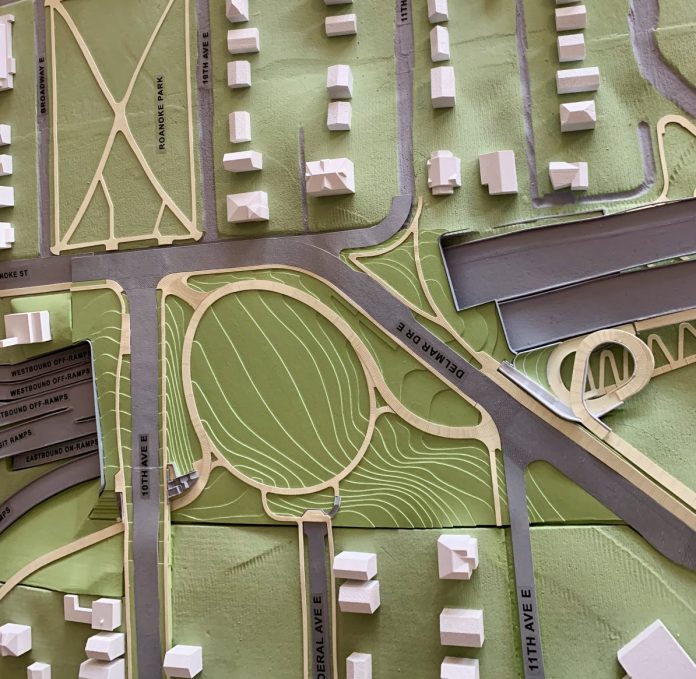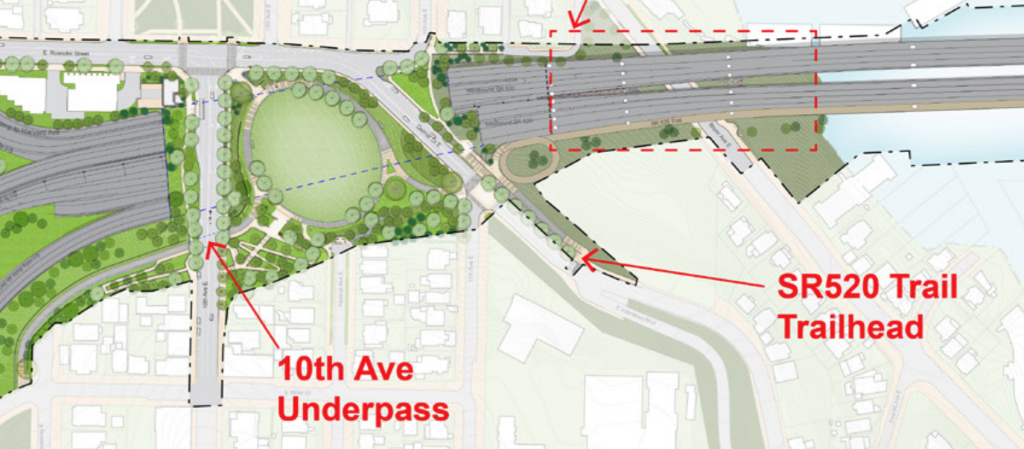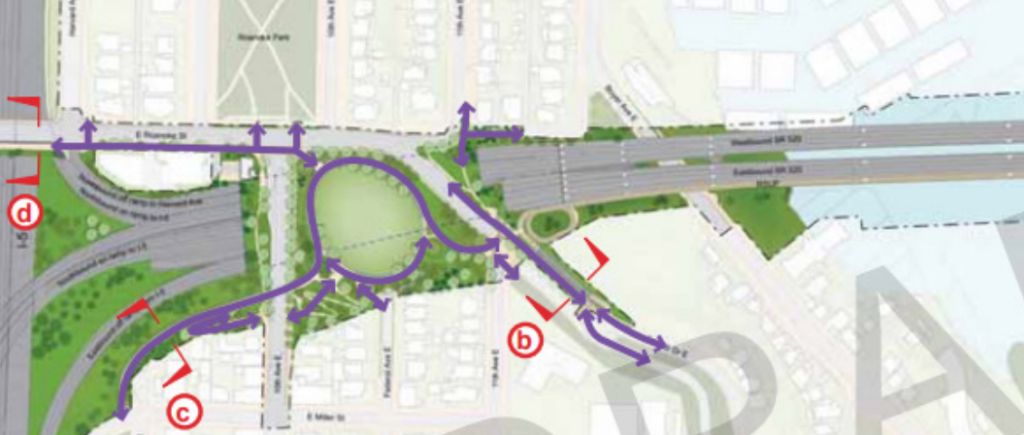
Cost savings obtained from dropping a long-planned multimodal connection from State Route 520’s Roanoke highway lid project in Seattle are expected to be fairly modest, according to new estimates provided by the Washington State Department of Transportation (WSDOT). The decision to delete the bike and pedestrian tunnel, announced just this month as the $1.375 billion final phase of the SR 520 bridge replacement project heads toward the start of construction, is drawing criticism from safe streets advocates for being short-sighted and out-of-alignment with local and state climate goals and mobility plans.
The tunnel underneath busy 10th Avenue E has been included in plans codified in 2019 and dating back even earlier, to a comprehensive study of bike and pedestrian connectivity in the area from 2014. Its inclusion would better integrate the highway lid with the North Capitol Hill street grid and a recently improved “Melrose Promenade” route to Summit Slope — or to South Lake Union via Lakeview Boulevard. The tunnel would offer those coming from the Harvard Avenue corridor safe and convenient access to an extended SR 520 Trail.
Earlier this year, in response to anticipated budget shortfalls within WSDOT’s budget toward the end of the decade, the state legislature asked WSDOT to look at potential scope changes that could reduce costs. But the total expected savings that come from not building the tunnel are only expected to be between $10 million and $15 million dollars, or 0.7% to 1.09% of the total project’s costs, according to WSDOT spokesperson Steve Peer.
Without the tunnel, people connecting to and from the lid — and a planned extension of the SR 520 multi-use trail across Lake Washington — with points west of 10th Avenue E will need to use surface streets, or may instead opt to cross I-5 at Roanoke Street and head through the Eastlake neighborhood. WSDOT, in its justification for deleting the connection, seems to be relying heavily on assuming that many people will do the latter, despite the generational opportunity that the lid represents to repair long-severed street grid connections and create new ones.

Although WSDOT only announced that deleting the 10th Avenue tunnel was on the table at the beginning of this month, Peer told The Urbanist that the decision has already been made to remove it. That decision pulls apart close to a decade of work to ensure maximum mobility benefits that come out of the project.
“We needed to move fast on making this decision because it significantly affects the design of the Roanoke Lid, and lid design is one of the earliest activities for the contractor,” Peer said. “We have notified our contractor of this change since it affects multiple other design elements of the Roanoke Lid.”
Prior to announcing the decision, Peer said WSDOT had already “touched base” with legislators in the 43rd district, local government partners including the Seattle Design Commission, and bike and pedestrian advocacy groups, including Washington Bikes, Cascade Bicycle Club, and Disability Rights Washington. He pledged work with the Seattle Department of Transportation (SDOT) on compensatory improvements.
“Feedback among agency partners was largely neutral or supportive,” Peer said. “Bicycle and pedestrian advocates acknowledged this was a loss but recognized the budget constraints. They encouraged us to coordinate with the city of Seattle to ensure they constructed planned greenway improvements in the area. Cyclists also expressed a preference for using Eastlake and 10th Ave East and support aligning WSDOT and SDOT investments along the Eastlake corridor. We are meeting with SDOT to align plans and resources for their bicycle and pedestrian improvements in the area.”
Other multimodal advocacy organizations disagree with WSDOT’s characterization of the impacts of this decision.
“It’s appalling that the cheapest and most sustainable parts of this project are on the chopping block first,” Nick Sattele with Central Seattle Greenways told The Urbanist. “The Roanoke Lid has the opportunity to heal a scar that today hinders walking, rolling, and biking around north Capitol Hill, and eliminating the Harvard underpass without providing a suitable replacement would betray promises to the community as well as climate goals.”

Asked if WSDOT had any other changes planned for the Roanoke Lid Project to reduce costs, Peer said yes, but that none were fully baked yet. “We’re considering a number of cost reduction opportunities – such as using different building materials – while maintaining function. These adjustments all require additional design and analysis to confirm feasibility,” he said.
To date, there have been no signs that WSDOT is examining scaling back any of the proposed space for vehicles in the proximity of the twin Portage Bay bridges, set to be replaced as part of this project, or the Roanoke Lid.
In an email Wednesday, 520 Program Administrator Omar Jepperson reiterated the reasons that WSDOT was moving forward with its decision to delete the tunnel, emphasizing the $700 million budget gap on the project, compared to estimates that WSDOT had created prior to soliciting bids from contractors, but did not directly disclose the 10 to 15 million dollars expected costs savings from this specific connection.
Jepperson also laid out the alternative routes that people biking or walking would likely choose now that the tunnel won’t exist. “When we considered removing the Harvard Connection, we analyzed comparable distance, time, elevation, and levels of traffic stress for alternative bike routes from Roanoke Park to both South Lake Union and downtown Seattle,” Jepperson said.
But the relatively minor costs associated with the tunnel suggest that its deletion is worth reconsideration. Late last year, the 520 program team within WSDOT responded to community concerns around the aesthetic features of three highway sign bridges near the under-construction highway lid in Montlake. After a few months of discussions, a proposal to scale back the sign bridges — work that includes a full replacement of one bridge that had already been installed — was advanced by WSDOT, with an expected total cost to the state of $750,000.
In the case of the 10th Avenue E tunnel, there has been even less public process than even that quick turnaround in Montlake, and the concerns here are far more than aesthetic.
Ryan Packer has been writing for The Urbanist since 2015, and currently reports full-time as Contributing Editor. Their beats are transportation, land use, public space, traffic safety, and obscure community meetings. Packer has also reported for other regional outlets including Capitol Hill Seattle, BikePortland, Seattle Met, and PubliCola. They live in the Capitol Hill neighborhood of Seattle.


